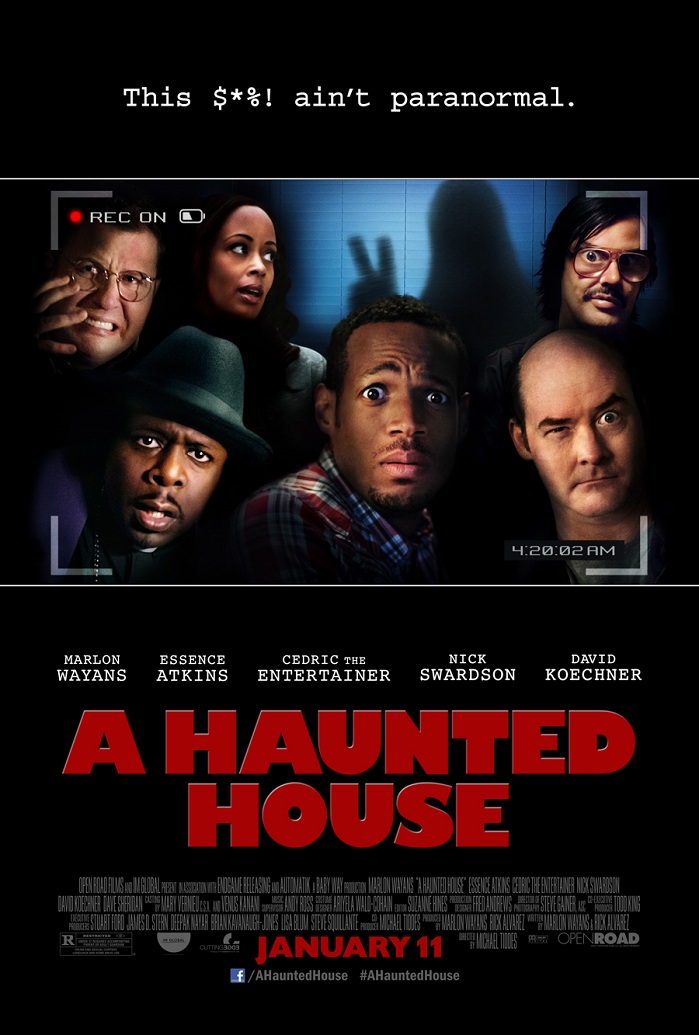SPIRITED COMEDY: THE MARLON WAYANS INTERVIEW
 Monday, May 20, 2013 at 9:59AM
Monday, May 20, 2013 at 9:59AM Given the recent dire efforts in the field of found footage horror, some may suggest a parody is a bit redundant. But for writer and comedian Marlon Wayans, there is still a lot that can be laughed at.

Breaking away from the big-screen act he perfected with his brothers Keenen and Shawn over the last decade in the hit films White Chicks and Little Man, Wayans has returned to the mockery of one of his franchise starter, Scary Movie, for his latest comedy, A Haunted House. “They did something special with the first Paranormal Activity film, like they did with the first Blair Witch movie. They did a really good job spinning the bullshit, making you believe the house was haunted,” Wayans tells SCREEN-SPACE while in Sydney for a series of sold-out stand-up shows. “But by the time Paranormal Activity 3 came out, I was thinking ‘Man, this is getting bad.’ It was time to make fun of them.”
 The film is a typically low-brow but occasionally hilarious send-up, with elements such as set design and narrative beats taken directly from the Paranormal Activity series as well as recent hits The Devil Inside and The Last Exorcism. Wayans fans won’t be at all surprised to learn the film is full of sexual innuendo and base crudity and that’s exactly the way they like it. “I make it for the kids, who don’t care too much what’s right and what’s wrong in the eyes of grown-ups, who just want to have a good laugh,” he says. “But I also make it for the 30 and 40 year-olds who still have that little kid inside of them and who want to be a little naughty and a little crass.”
The film is a typically low-brow but occasionally hilarious send-up, with elements such as set design and narrative beats taken directly from the Paranormal Activity series as well as recent hits The Devil Inside and The Last Exorcism. Wayans fans won’t be at all surprised to learn the film is full of sexual innuendo and base crudity and that’s exactly the way they like it. “I make it for the kids, who don’t care too much what’s right and what’s wrong in the eyes of grown-ups, who just want to have a good laugh,” he says. “But I also make it for the 30 and 40 year-olds who still have that little kid inside of them and who want to be a little naughty and a little crass.”
It is a formula that has proved enormously successful for Wayans; budgeted at around US$2million, the film became a sleeper hit Stateside, grossing nearly $45million. The final tally is doubly impressive given the film took a critical savaging from the mainstream media, very few of whom have ever sided with the young comic’s popular appeal. He takes their disdain philosophically. “I think sometimes critics tend to overthink comedy. I think they should watch some comedies with a paying audience and watch the audience reaction,” Wayans theorises. “Then they can say ‘Well, it wasn’t my thing, but the audience seemed to love it’. That would be the fairer thing to do with a lot of comedies, because what makes each of us laugh is such a subjective thing. Some people think themselves too intelligent, or too above, a good fart joke.”
 Body functions are just one of the many avenues explored by Wayans and his co-stars David Koechner, Nick Swardson (pictured, right, with Wayans), Cedric the Entertainer and Essence Atkins (“She had a baby five weeks before we started filming, but she still got on the rig and let us pull her around. She was incredible.’) Free-wheeling their way through many improvised moments, the cast push a lot of boundaries in terms of physical humour; in one scene, Wayans enjoys a wild sexual encounter with two stuffed toys. Wayans agrees that there’s not much he won’t do for a laugh. “Oh man, I go there! I’m absolutely happy to go there,” he says with laugh. “Comedy has always got to be all or nothing. But you have to have layers, of course, and I think with this movie we accomplished that.”
Body functions are just one of the many avenues explored by Wayans and his co-stars David Koechner, Nick Swardson (pictured, right, with Wayans), Cedric the Entertainer and Essence Atkins (“She had a baby five weeks before we started filming, but she still got on the rig and let us pull her around. She was incredible.’) Free-wheeling their way through many improvised moments, the cast push a lot of boundaries in terms of physical humour; in one scene, Wayans enjoys a wild sexual encounter with two stuffed toys. Wayans agrees that there’s not much he won’t do for a laugh. “Oh man, I go there! I’m absolutely happy to go there,” he says with laugh. “Comedy has always got to be all or nothing. But you have to have layers, of course, and I think with this movie we accomplished that.”
He is also proud of the way he and first-time director Michael Tiddes adapted the clichéd use of the camera in found footage films for comedy impact. “The style of the movie we were sending up, all that handheld stuff and the CCTV footage, was able to be used to our comedic advantage,” he explains. “We were able to let a group of very funny people just do take after take of really funny stuff, just non sequitur, bizarrely funny shit that, if it worked, we would use it. Absolutely the aim was to do a comedy version of a found footage movie.”
A Haunted House opens in Australia on May 30. Follow Marlon Wayans on Twitter here.














